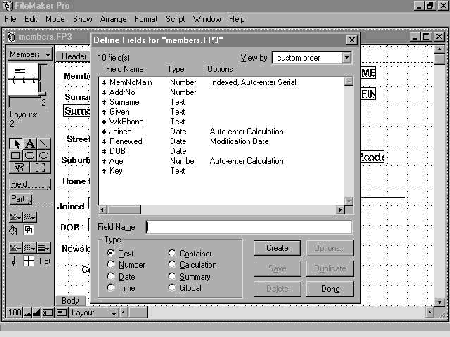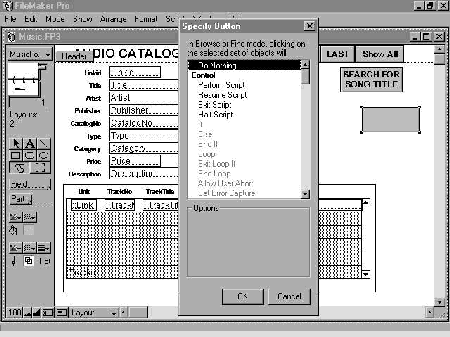


Installation was no problem, with choice of drive and directory name. I am using Windows 95 and an entry in the "Add/Remove Programs" section of the Control Panel had been made to select easy removal of the application. The trial version takes about 2.3Mb of disk space; the full version takes up extra space for the omitted features. Limitations with the trial version are: the ability to have up to 50 records only in a file, lack of tutorial files spelling checker and help, unable to import graphics, and no network access. But it gives a fully working version of a relational database that allows for complete testing of its features.
I found the lack of the help file to be a disadvantage, because I am used to databases and I knew what I wanted to do. The question was: how to make this database do the things I wanted? The fact that I was able to make up test files and use most of the features shows that it is user-friendly and not difficult to learn and use.
The trial software comes with a four page documentation file which gives a small tutorial on existing sample files. It takes you through using a template to start a new database, setting up a relationship between two files and the use of the "Portal windows" (sub form) to display records from the linked database on the form of the main database, merging information, creating labels and formatting a merge letter.

I created a simple address database using a template (Figure 1) but as with most templates, the layout didn't really suit the data I wanted to store. I dumped some data from another address program, and had no trouble importing the comma delimited text file into my empty database. There was a nice set up to select which field to import to the pre-defined fields, and either side could be skipped (Figure 2). When importing or exporting data there is a choice of four character sets: Windows (ANSI), DOS, Macintosh and Lotus (LICS). My Macintosh files were using the Macintosh character set, and those files which I created on the PC were using the Windows (ANSI) set quite seamlessly.

Creating a database from scratch is well presented. The fields are easy to define and don't require a set length to be thought of in the planning. Field types are text, number, date, time, container (for graphics?), calculation, summary and global. Further formatting is available in the data declaration area or on the form in layout view. After the fields are created, the form is automatically created, with a choice of styles. List boxes, drop down menus, check boxes and radio buttons are easily set up directly on the form. Boolean fields are best handled by radio buttons or check boxes with a Value List of "Yes" and "No". Fields may be altered, or extra fields added as an afterthought, by using File/Define Fields (Figure 3).

There is a full selection of all your installed Windows fonts.
There is a menu system formula builder available with a comprehensive list of formulae. I tested the use of a calculated field set to produce a person's age if the birthdate is given. Although the set up of this calculation varies in each database I have used, I had little trouble finding the right syntax, which was simpler than the one needed for Microsoft Access; there is an option not to calculate the value if any of the referenced fields is empty, so that saved the use of the IF (or IIF) statement that is necessary in other databases.
I created a duplicate of a set up I have in Microsoft Access which keeps a main table of CDs, and a related table of all the tracks. I had no problem defining the fields for the two databases and then relating the link field (CD number), and placing the records from the second (tracks) database to show at the bottom of the CD form. This was done using a Portal window on the CD form. Viewing and data entry worked well. I tested other relational set ups, including one with three linked files. All came together very well with no problems in getting the correct results from the linked fields.
Attaching commands or Scripts to buttons was quite straightforward with a good menu listing all actions that can be performed "live" on the database from the user menus. These commands are grouped by Control (program statements), Navigation, Sort/Find/Print, Editing, Fields, Records, Import/Export, Window, Files, Spelling and Miscellaneous (Figure 4).

A button can have either one control, or a Script attached. A Script will perform a series of controls. Scripts (macros) were easy to create from the drop down list of all actions, functions and script language.
The highlight of FileMaker Pro for me, was transporting a file across from a Macintosh (PowerMac). I just simply dragged the file from the list to the MS-DOS disk icon. I changed the file name to something more intelligent to DOS as I copied it to my PC. File/Open, selecting the file, produced a message that the file was of a previous version and would be converted. All data, forms, layouts, letters, summaries and mail labels came across perfectly.
I can say no more than Luke Myers (APC October 1996): A simple, effective [relational] database package for individual or shared information.
The power of a relational database at the cost of little disk space.
Good menu system of commands for ease of use.
Using online networking, both Macintosh and PC can share the same data for both viewing and editing.
Problem-free conversion from Macintosh platform to PC.
Built-in mail merge features with form letters and labels.
Modem link capabilities
Lacks the ability to create saved filters or queries.
No recently used files list.
No true browse view unless you carefully design it.
Location of files; there is no preference to set the directory from which to open files. I set the "Start in" option of the application icon to my preference, but if I happened to open a file from another location during a session, the File/Open would not automatically return to my preferred directory.
Distributor Claris
Price $349
Online: http://www.claris.com
 Back to Nov 1996 Index
Back to Nov 1996 Index